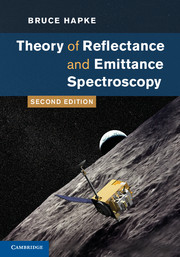Book contents
- Frontmatter
- Contents
- Acknowledgments
- 1 Introduction
- 2 Electromagnetic wave propagation
- 3 The absorption of light
- 4 Specular reflection
- 5 Single-particle scattering: perfect spheres
- 6 Single-particle scattering: irregular particles
- 7 Propagation in a nonuniform medium: the equation of radiative transfer
- 8 The bidirectional reflectance of a semi-infinite medium
- 9 The opposition effect
- 10 A miscellany of bidirectional reflectances and related quantities
- 11 Integrated reflectances and planetary photometry
- 12 Photometric effects of large-scale roughness
- 13 Polarization of light scattered by a particulate medium
- 14 Reflectance spectroscopy
- 15 Thermal emission and emittance spectroscopy
- 16 Simultaneous transport of energy by radiation and thermal conduction
- Appendix A A brief review of vector calculus
- Appendix B Functions of a complex variable
- Appendix C The wave equation in spherical coordinates
- Appendix D Fraunhofer diffraction by a circular hole
- Appendix E Table of symbols
- Bibliography
- Index
9 - The opposition effect
Published online by Cambridge University Press: 05 January 2012
- Frontmatter
- Contents
- Acknowledgments
- 1 Introduction
- 2 Electromagnetic wave propagation
- 3 The absorption of light
- 4 Specular reflection
- 5 Single-particle scattering: perfect spheres
- 6 Single-particle scattering: irregular particles
- 7 Propagation in a nonuniform medium: the equation of radiative transfer
- 8 The bidirectional reflectance of a semi-infinite medium
- 9 The opposition effect
- 10 A miscellany of bidirectional reflectances and related quantities
- 11 Integrated reflectances and planetary photometry
- 12 Photometric effects of large-scale roughness
- 13 Polarization of light scattered by a particulate medium
- 14 Reflectance spectroscopy
- 15 Thermal emission and emittance spectroscopy
- 16 Simultaneous transport of energy by radiation and thermal conduction
- Appendix A A brief review of vector calculus
- Appendix B Functions of a complex variable
- Appendix C The wave equation in spherical coordinates
- Appendix D Fraunhofer diffraction by a circular hole
- Appendix E Table of symbols
- Bibliography
- Index
Summary
Introduction
The opposition effect is a sharp surge observed in the reflected brightness of a particulate medium around zero phase angle. Its name derives from the fact that the phase angle is zero for solar-system objects at astronomical opposition when the Sun, the Earth, and the object are aligned. Depending on the material the angular width of the peak can range from about 1° to more than 20°. It has many names including the heiligenschein (literally “holy glow”), hot spot, bright shadow and backscatter peak. We have already encountered the opposition effect peak in Figures 8.12 and 8.18. and it is further illustrated in Figures 9.1–9.3. It should not be confused with the glory in the phase function of a sphere (Chapter 5), which is also often called the heiligenschein.
The opposition effect is a nearly ubiquitous property of particulate media, including vegetation (Hapke et al., 1996), laboratory powders (Hapke andVan Horn, 1963; Oetking, 1966; Egan and Hilgeman, 1976; Montgomery and Kohl, 1980; Nelson et al., 1998, 2000), and regoliths of the Moon (Gehrels et al., 1964; Whitaker, 1969; Wildey, 1978; Buratti et al., 1996), Mars (Thorpe, 1978), asteroids (Gehrels et al., 1964; Bowell and Lumme, 1979; Belskaya and Shevchenko, 2000), satellites of the outer planets (Brown and Cruikshank, 1983; Domingue et al., 1991), and the rings of Saturn (French et al., 2007). On a clear day you can see it as a glow around the shadow of your head when your shadow falls on grass or soil.
- Type
- Chapter
- Information
- Theory of Reflectance and Emittance Spectroscopy , pp. 221 - 262Publisher: Cambridge University PressPrint publication year: 2012
- 1
- Cited by



